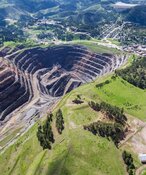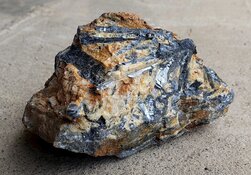The Gold Report: John Wilson, a senior portfolio manager with Sprott Asset Management, said recently that investors tend to get more comfortable with equity markets when equity markets are riding high versus when equity markets are riding low. What are your thoughts?
Adrian Day: That's true; you see that in the broad market and in the gold market. The broad market has been a pretty steady move up from the middle of November until now, and yet all the way through the beginning of January the public was still very heavy sellers, not buyers, of equities. Then they started buying in January.
"Stocks of companies that have good balance sheets and inexpensive or very good projects and are advancing them nicely are doing reasonably well despite the overall negativity in the sector."
If you look at the gold stocks, you need to be very discriminating about what you buy. A lot of the senior companies have had management shakeups because of bad acquisitions or overpriced acquisitions, capital expenditure (capex) overruns and bad capital allocation decisions; a lot of decisions were made in the last few years simply for the sake of getting bigger. For a few years, the market was indiscriminate, and everything was going up. But for the last six months, the market generally has been a lot more discriminating. Stocks of companies that have good balance sheets and inexpensive or very good projects and are advancing them nicely are doing reasonably well despite the overall negativity in the sector. Some amazing companies are selling at very good prices, and yet nobody seems interested right now.
TGR: Is your gold portfolio mostly equities? Do you dabble in exchange-traded funds (ETFs)?
AD: We buy physical bullion and ETFs. We have been known to buy bonds, although we're not buying any bonds at the moment. The portfolio is primarily equities.
TGR: You allocate a portion of your clients' portfolios to juniors, but you also have significant positions in larger-cap gold equities. John Paulson said in late March that he believes that gold companies need to get smaller and spin out some of their mines into other companies and operate on a much smaller scale. Do you think that's realistic, and do you think that that's a sound approach to generating shareholder value?
AD: I would flip it around and say that companies need to stop fixating on getting bigger simply for the sake of getting bigger. That doesn't necessarily mean that companies have to get smaller, but certainly a smaller profitable company is a better company than a larger unprofitable company.
"Some amazing companies are selling at very good prices, and yet nobody seems interested right now."
The model has changed a lot in the last 30 years. In the 1960s and 1970s, the biggest mines and the biggest companies in the world were the South African ones, and generally they were single-mine companies. Some mines had relatively short lives; other mines had multidecade lives. The companies would generate revenue and pay that revenue out as dividends to shareholders, hence the dividends were high. Over the years the model changed from being single-mine companies to ongoing enterprises. The problem with the ongoing enterprise model is that when you're a Newmont Mining Corp. (NEM:NYSE) or a Barrick Gold Corp. (ABX:TSX; ABX:NYSE), it is extremely difficult to find 5–7 million ounces (5–7 Moz) gold per year, so you end up buying it. No company wants to shrink, so if you're producing 7 Moz, you better find 7 Moz. If that means buying it, so be it. If it means overpaying, that's the price you pay to keep growing. That is a mistake.
We're going to see companies focus more on profitable growth. That will inevitably mean slower growth or even, at periods, no growth. I don't think many companies are going to deliberately aim for lower growth, but that's going to be a byproduct of companies focusing on profitable growth. Barrick, which is the largest gold miner in the world, recently said that its metric for acquisitions is going to be return on equity. That is novel for many mining companies.
We can all think of acquisitions that shouldn't have taken place or mines under construction that perhaps shouldn't be under construction: Costs at Barrick Gold's Pascua Lama mine have gone up threefold since original estimates. This is a mine on the border of Chile and Argentina, and it's going to be pretty tricky to mine and process without disturbing the glaciers. Other overpriced acquisitions include Kinross Gold Corp.'s (K:TSX; KGC:NYSE) Tasiast and Newmont's Hope Bay, acquisitions that at the right price would've made a lot of sense, but these were just too expensive.
TGR: You put your clients into mining royalty companies, which is about gaining exposure to higher commodity prices but at a lower risk. What sort of exposure do your clients have today to royalty plays versus what they did 5–10 years ago?
AD: There are more royalty companies available today and that has enabled us to buy more.
For investors, the main goal should be to mitigate risk. How do you mitigate the risk that's inherent in the business? For the bigger, senior companies, the biggest risks are replacing ounces produced because a mine is a depleting asset, and the continual things that go wrong with a mining operation. The big royalty companies that actually have revenue from various royalties mitigate that risk to a very large extent. Once you've bought a royalty, your first dollar in is your last dollar in. You're not obligated to pay for cost overruns. If the government increases taxes, you don't have to pay them. If the water table breaks and the mine shaft floods, you don't have to pay to fix it. You mitigate the risk by avoiding all those unforeseen additional expenses. Pascua Lama's capex has gone from $2.5 billion ($2.5B) to $8B. Barrick has to pay that, but the owner of the royalty doesn't. The owner of a royalty just has to be a little patient and wait for the mine to finally get built and produce gold. That's a big benefit. We like the royalty model a lot.
In addition to that, the margins are extremely high, and you still have the benefit of exposure to exploration, whether it's from brownfields exploration around existing mine sites, assuming you own a royalty on the surrounding ground, or whether it's new mines where you've got a royalty on a mine in development.
But just because you own a royalty doesn't make it a risk-free investment. If Mining Company A decides not to build a mine because of a government tax increase, you the royalty owner don't get your royalty. If the price of gold drops considerably, then your royalty is worth a lot less, because the revenues you get are a lot less. If the mining company decides not to do the expansion, you don't get your additional revenue.
Along the same line, in the juniors the biggest risk is the long odds of actually finding something that becomes a mine. I like to mitigate that risk by buying companies that have multiple projects or companies that use the prospect-generator model where they don't have to continually raise money themselves to put into the ground but have partners to spend the money and so, again, you mitigate what is the biggest risk in the business.
TGR: Randy Smallwood, the CEO of Silver Wheaton Corp. (SLW:TSX; SLW:NYSE), said that he looks for assets that are management proof when he's seeking to buy preexisting production at a given rate. When we talk to numerous pundits in this industry, it's always about management, management, management, but on the royalty side, it seems as if the asset is more important.
AD: That's probably true.
TGR: There are basically two ways these companies make their money. One is with a royalty, so if it's a 5% royalty and a company produces 10,000 ounces (10,000 oz) gold, the royalty company is going to be taking 500 oz. The other is through streaming: the company buys production before it's produced and then sells it at the market price later. Which do you prefer?
AD: The prime benefit to the royalty is that royalties are typically on the ground itself, on the mine itself, and are not affected by changes in ownership of the mine. The main benefit of a stream is apparent when you look at the totality of the money that you're putting up. A lot of that money is put up not upfront but is put up to buy each ounce that comes out of the ground at a very low cost, for instance, silver royalties are often $4/oz. If the mine totally gets messed up, you stop making payments, whereas with the royalty, you've already made the payment upfront. There are benefits to each, but royalties are cleaner, so it's a lot easier to analyze a royalty on an ongoing basis. Streams can start to get pretty complicated if the company doesn't produce the ounces in any given year, if the price of the commodity goes up, etc. It's not the end of the world if the payment from silver goes from $4/oz to $5/oz, because the price of silver went from $30/oz to $35/oz. It just makes it a little bit more difficult to analyze.
TGR: Most royalty companies generate their cash from precious metals–producing companies, yet there isn't a royalty play with a focus on platinum group metals (PGM) or even base metals. Should investors expect to see those types of royalty companies in the future?
AD: Most of the royalty companies do have a certain amount of their revenue from non-gold. Franco-Nevada Corp. (FNV:TSX; FNV:NYSE) has a royalty on Stillwater Mining Co. (SWC:NYSE), which is PGM. When Royal Gold Inc. (RGLD:NASDAQ; RGL:TSX) bought International Royalty Corp., it got the Voisey's Bay nickel royalty. Then there is a royalty company that is entirely devoted to non-gold royalties, Sandstorm Metals & Energy Ltd. (SND:TSX.V), the sister company of Sandstorm Gold Ltd. (SSL:TSX). Sandstorm Metals & Energy hasn't grown as rapidly as Sandstorm Gold has.
TGR: There are a number of newcomers to the royalty space over the last few years and especially in the last six months. Do you expect this relative proliferation to continue?
AD: Yes. It's an easier business in that it's less high risk than operating a mine. Royalty companies have become rather expensive. The stock valuations that you can attract by having a royalty company are a lot better than the valuations from actually mining. I think newcomers make things healthy, because the competition is good in that it keeps the business profile going. But we are beginning to see the space rather crowded with some less-than-efficient players, and premium valuations.
TGR: Which small-cap royalty plays are you following?
AD: There are two groups that we're following. One is exploration companies that have a royalty or royalties and are developing more royalties. The other is smaller companies that are pure royalty companies.
"We're going to see companies focus more on profitable growth."
Of the former, I have three favorite companies. One is Virginia Mines Inc. (VGQ:TSX). The company has a very attractive royalty on the Éléonore deposit that it discovered a few years ago and sold to Goldcorp Inc. (G:TSX; GG:NYSE). When Virginia sold the project, it kept a royalty. That mine is Goldcorp's next flagship property, and it's on track for production last quarter of next year. At that point, that royalty will generate at today's price of gold around $30 million a year for the next 17 years. The value of that royalty alone is worth more than Virginia's whole market cap. Virginia has other royalties from exploration projects, but none close to production.
Altius Minerals Corp. (ALS:TSX.V) is another company that I like a lot. It has a producing royalty, part of the Voisey's Bay royalty, that pays for all of its annual general and administrative expenses. Altius uses the prospect-generator model but with a bit of a twist. It generates prospects and finds partners to come in, and then it spins that into a separate company. Altius retains 25%, 30%, 40% of the shares and a royalty. It uses the shares as a source of cash so it doesn't have to go to the market, but it always keeps these royalties. It has a lot of royalties on the books. Voisey's Bay is already producing, and it has a very attractive royalty on an iron ore project known as Kami.
TGR: That's Alderon Iron Ore Corp.'s (ADV:TSX; AXX:NYSE.MKT) main project, correct?
AD: Yes. Altius discovered Kami. The company brought in the partner and put it into a separate company called Alderon Iron Ore, and so now it is a separate company, developing and advancing the project. Alderon published a very attractive feasibility in January. Alderon has a Chinese steel company, Hebei, as a partner, which has just agreed to put up the final round of financing so Hebei now owns 25% of Kami. Alderon owns 75%. Altius owns about 30% of Alderon and a royalty on the project.
Altius also has a lot of exploration projects, such as in Newfoundland. The key to Altius is it's continuing to generate projects. Six months ago it undertook a new joint venture program in Chile where the company has a local partner putting up most of the money.
Eurasian Minerals Inc. (EMX:TSX.V) is the third of these companies that I really like. Eurasian last year acquired a small royalty company called Bullion Monarch, which had producing royalties. Eurasian paid for it with both cash and shares, but the royalties from Bullion Monarch now cover Eurasian's overhead. Eurasian is a prospect generator with properties in gold and copper around the world. It tends to focus on larger companies as its partners. Smaller companies are more aggressive; larger companies have more money. Eurasian's partners include Newmont in Haiti, Freeport-McMoRan Copper & Gold Inc. (FCX:NYSE) in Arizona and Russia, Antofagasta PLC (ANTO:LSE) in Sweden, and others in Serbia and Turkey. It looks to keep a royalty on all of these projects.
We also follow smaller companies that are pure royalty companies. My favorites are Callinan Royalties Corp. (CAA:TSX.V) and Gold Royalties Corp. (GRO:TSX.V).
Callinan was founded by Roland Butler, who was one of the founders of Altius. His expertise is in exploration, so what Callinan tends to do is look at very early-stage exploration and try to do some kind of joint venture with the company where it puts some money in return for a royalty on any future production. As an example, it did a strategic alliance transaction similar to that with a prospect generator called Evrim Resources Corp. (EVM:TSX.V), based in Mexico. Evrim was founded a couple of years ago and acquired a lot of Rimfire's properties and joint ventures in Mexico. Callinan also has a couple of producing royalties from which it pays a nice dividend, with a current 3.4% yield. The potential over the long term is excellent.
Gold Royalties is a relatively new company with a very interesting twist on the business, which is the company is looking to be a consolidator in the royalty business. It signed an agreement with Franco-Nevada whereby Franco has the right to participate in up to 50% in certain royalties that Gold Royalties comes across. It's as great deal for Franco because it can increase its royalty portfolio without putting the time or the people into looking for small royalties. It's also a good deal for Gold Royalties because it can acquire royalties larger than it otherwise could. Its objective is to act as a consolidator such as you see in private equity or business development companies.
TGR: Do you have some parting thoughts?
AD: Royalties are a very low-risk way of getting exposure to the precious metals mining sector. If you're interested in seniors, look at Franco-Nevada and Royal Gold. If you're interested in exploration, look at Gold Royalties, Callinan, Altius, Virginia and Eurasian. But just because you have a royalty company doesn't mean that it's not exposed to the vagaries of the market, the gold price as well as specific problems with specific mines, but it's certainly a much lower-risk way of playing the market.
TGR: Thank you.
Adrian Day, London born and a graduate of the London School of Economics, heads the eponymous money management firm Adrian Day Asset Management, where he manages discretionary accounts in both global and resource areas. His latest book is "Investing in Resources: How to Profit from the Outsized Potential and Avoid the Risks."
Want to read more Gold Report interviews like this? Sign up for our free e-newsletter, and you'll learn when new articles have been published. To see a list of recent interviews with industry analysts and commentators, visit our Streetwise Interviews page.
DISCLOSURE:
1) Brian Sylvester conducted this interview for The Gold Report and provides services to The Gold Report as an independent contractor. He or his family own shares of the following companies mentioned in this interview: None.
2) The following companies mentioned in the interview are sponsors of The Gold Report: Franco-Nevada Corp., Royal Gold Inc., Goldcorp Inc. and Gold Royalties Corp. Streetwise Reports does not accept stock in exchange for its services or as sponsorship payment.
3) Adrian Day: I or my family own shares of the following companies mentioned in this interview: Franco-Nevada Corp., Royal Gold Inc., Altius Minerals Corp., Sandstorm Metals & Energy Ltd., Eurasian Minerals Inc. and Virginia Mines Inc. Money management clients own shares in all companies recommended. I personally or my family am paid by the following companies mentioned in this interview: None. My company has a financial relationship with the following companies mentioned in this interview: None. I was not paid by Streetwise Reports for participating in this interview. Comments and opinions expressed are my own comments and opinions. I had the opportunity to review the interview for accuracy as of the date of the interview and am responsible for the content of the interview.
4) Interviews are edited for clarity. Streetwise Reports does not make editorial comments or change experts' statements without their consent.
5) The interview does not constitute investment advice. Each reader is encouraged to consult with his or her individual financial professional and any action a reader takes as a result of information presented here is his or her own responsibility. By opening this page, each reader accepts and agrees to Streetwise Reports' terms of use and full legal disclaimer.
6) From time to time, Streetwise Reports LLC and its directors, officers, employees or members of their families, as well as persons interviewed for articles and interviews on the site, may have a long or short position in securities mentioned and may make purchases and/or sales of those securities in the open market or otherwise.




































